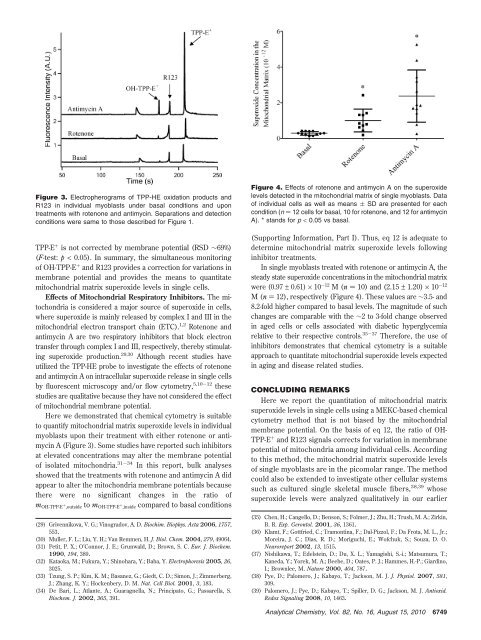Analytical Chemistry Chemical Cytometry Quantitates Superoxide
Analytical Chemistry Chemical Cytometry Quantitates Superoxide
Analytical Chemistry Chemical Cytometry Quantitates Superoxide
You also want an ePaper? Increase the reach of your titles
YUMPU automatically turns print PDFs into web optimized ePapers that Google loves.
Figure 3. Electropherograms of TPP-HE oxidation products and<br />
R123 in individual myoblasts under basal conditions and upon<br />
treatments with rotenone and antimycin. Separations and detection<br />
conditions were same to those described for Figure 1.<br />
TPP-E + is not corrected by membrane potential (RSD ∼69%)<br />
(F-test: p < 0.05). In summary, the simultaneous monitoring<br />
of OH-TPP-E + and R123 provides a correction for variations in<br />
membrane potential and provides the means to quantitate<br />
mitochondrial matrix superoxide levels in single cells.<br />
Effects of Mitochondrial Respiratory Inhibitors. The mitochondria<br />
is considered a major source of superoxide in cells,<br />
where superoxide is mainly released by complex I and III in the<br />
mitochondrial electron transport chain (ETC). 1,2 Rotenone and<br />
antimycin A are two respiratory inhibitors that block electron<br />
transfer through complex I and III, respectively, thereby stimulating<br />
superoxide production. 29,30 Although recent studies have<br />
utilized the TPP-HE probe to investigate the effects of rotenone<br />
and antimycin A on intracellular superoxide release in single cells<br />
by fluorescent microscopy and/or flow cytometry, 5,10-12 these<br />
studies are qualitative because they have not considered the effect<br />
of mitochondrial membrane potential.<br />
Here we demonstrated that chemical cytometry is suitable<br />
to quantify mitochondrial matrix superoxide levels in individual<br />
myoblasts upon their treatment with either rotenone or antimycin<br />
A (Figure 3). Some studies have reported such inhibitors<br />
at elevated concentrations may alter the membrane potential<br />
of isolated mitochondria. 31-34 In this report, bulk analyses<br />
showed that the treatments with rotenone and antimycin A did<br />
appear to alter the mitochondria membrane potentials because<br />
there were no significant changes in the ratio of<br />
mOH-TPP-E + ,outside to mOH-TPP-E + ,inside compared to basal conditions<br />
(29) Grivennikova, V. G.; Vinogradov, A. D. Biochim. Biophys. Acta 2006, 1757,<br />
553.<br />
(30) Muller, F. L.; Liu, Y. H.; Van Remmen, H. J. Biol. Chem. 2004, 279, 49064.<br />
(31) Petit, P. X.; O’Connor, J. E.; Grunwald, D.; Brown, S. C. Eur. J. Biochem.<br />
1990, 194, 389.<br />
(32) Kataoka, M.; Fukura, Y.; Shinohara, Y.; Baba, Y. Electrophoresis 2005, 26,<br />
3025.<br />
(33) Tzung, S. P.; Kim, K. M.; Basanez, G.; Giedt, C. D.; Simon, J.; Zimmerberg,<br />
J.; Zhang, K. Y.; Hockenbery, D. M. Nat. Cell Biol. 2001, 3, 183.<br />
(34) De Bari, L.; Atlante, A.; Guaragnella, N.; Principato, G.; Passarella, S.<br />
Biochem. J. 2002, 365, 391.<br />
Figure 4. Effects of rotenone and antimycin A on the superoxide<br />
levels detected in the mitochondrial matrix of single myoblasts. Data<br />
of individual cells as well as means ( SD are presented for each<br />
condition (n ) 12 cells for basal, 10 for rotenone, and 12 for antimycin<br />
A). * stands for p < 0.05 vs basal.<br />
(Supporting Information, Part I). Thus, eq 12 is adequate to<br />
determine mitochondrial matrix superoxide levels following<br />
inhibitor treatments.<br />
In single myoblasts treated with rotenone or antimycin A, the<br />
steady state superoxide concentrations in the mitochondrial matrix<br />
were (0.97 ± 0.61) × 10 -12 M(n ) 10) and (2.15 ± 1.20) × 10 -12<br />
M(n ) 12), respectively (Figure 4). These values are ∼3.5- and<br />
8.2-fold higher compared to basal levels. The magnitude of such<br />
changes are comparable with the ∼2 to 3-fold change observed<br />
in aged cells or cells associated with diabetic hyperglycemia<br />
relative to their respective controls. 35-37 Therefore, the use of<br />
inhibitors demonstrates that chemical cytometry is a suitable<br />
approach to quantitate mitochondrial superoxide levels expected<br />
in aging and disease related studies.<br />
CONCLUDING REMARKS<br />
Here we report the quantitation of mitochondrial matrix<br />
superoxide levels in single cells using a MEKC-based chemical<br />
cytometry method that is not biased by the mitochondrial<br />
membrane potential. On the basis of eq 12, the ratio of OH-<br />
TPP-E + and R123 signals corrects for variation in membrane<br />
potential of mitochondria among individual cells. According<br />
to this method, the mitochondrial matrix superoxide levels<br />
of single myoblasts are in the picomolar range. The method<br />
could also be extended to investigate other cellular systems<br />
such as cultured single skeletal muscle fibers, 38,39 whose<br />
superoxide levels were analyzed qualitatively in our earlier<br />
(35) Chen, H.; Cangello, D.; Benson, S.; Folmer, J.; Zhu, H.; Trush, M. A.; Zirkin,<br />
B. R. Exp. Gerontol. 2001, 36, 1361.<br />
(36) Klamt, F.; Gottfried, C.; Tramontina, F.; Dal-Pizzol, F.; Da Frota, M. L., Jr.;<br />
Moreira, J. C.; Dias, R. D.; Moriguchi, E.; Wofchuk, S.; Souza, D. O.<br />
Neuroreport 2002, 13, 1515.<br />
(37) Nishikawa, T.; Edelstein, D.; Du, X. L.; Yamagishi, S.-i.; Matsumura, T.;<br />
Kaneda, Y.; Yorek, M. A.; Beebe, D.; Oates, P. J.; Hammes, H.-P.; Giardino,<br />
I.; Brownlee, M. Nature 2000, 404, 787.<br />
(38) Pye, D.; Palomero, J.; Kabayo, T.; Jackson, M. J. J. Physiol. 2007, 581,<br />
309.<br />
(39) Palomero, J.; Pye, D.; Kabayo, T.; Spiller, D. G.; Jackson, M. J. Antioxid.<br />
Redox Signaling 2008, 10, 1463.<br />
<strong>Analytical</strong> <strong>Chemistry</strong>, Vol. 82, No. 16, August 15, 2010<br />
6749

















